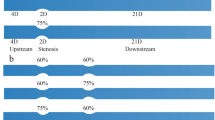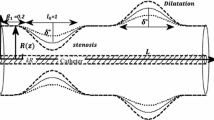Abstract
In this article pulsatile nature of blood flow through unsymmetric stenosed tapered artery in the presence of catheter has been modelled. Blood is represented by micropolar fluid. The analytical solutions for velocity and microrotation components are obtained in terms of Bessel functions of the first and second kind. Flow parameters such as the resistance to flow (impedance) in the artery and wall shear stress at the maximum height of the stenosis have been calculated and the effects of various parameters such as shape parameter (\(n\)), tapered parameter (\(\zeta \)), slip velocity (\(u_{1}\), \(u_{2}\)), radius of the catheter (\(r_{c}\)), Reynolds number (\(Re\)), Strouhal number (\(\sigma \)), micropolar parameter (\(m\)), coupling number (\(N\)) and height of the stenosis (\(\epsilon \)) on impedance and wall shear stress are discussed. The locations of the maximum height of the stenosis and the annular radius which are dependent on both tapered parameter (\(\zeta \)) and shape parameter (\(n\)) are computed. It is observed that impedance is increasing while catheter radius, height of the stenosis, coupling number are increasing, while it is decreasing in case of shape parameter and micropolar parameter. Shape parameter has no effect on wall shear stress at the maximum height of the stenosis in case of non-tapered artery. However it is dependent on \(n\) in case of tapered artery. In particular wall shear stress decreases as stenosis is becoming more and more asymmetric in case of diverging tapered artery and the behaviour is exactly reverse in case of converging tapered artery. Also a comparison of the results for impedance of the present model with the experimental results of Back [4] have been carried out, it is observed that impedance increases significantly for higher values of the ratio of the radius of the catheter to that of the annular region is high.




















Similar content being viewed by others
References
Roose R, Lykoudis PS (1971) The fluid mechanics of the ureter. J Fluid Mech 46:625–630
Karahalios GT (1990) Some possible effects of a catheter on the arterial wall. Med Phys 17(5):922–925
Back LH, Denton TA (1992) Some arterial wall shear stress estimates in coronary angioplasty. Adv Bioengg 22:337–340
Back LH (1994) Estimated mean flow resistance increase during coronary artery catheterization. J Biomech 27(2):169–175
Back LH, Kwack EY, M R (1996) Flow rate—pressure drop relation in coronary angioplasty—catheter obstruction effect. J Biomech Engg 118(1):83–89
Jayaraman G, Tewari K (1995) Flow in a catheterised curved artery. Med Biol Engg Comput 33(5):720–724
Rao AR, Srinivasan U (1995) Peristaltic pumping in a circular tube in the presence of an eccentric catheter. J Biomech Engg Trans ASME 117:448–454
Young DF (1968) Effect of time dependent stenosis on flow through a tube. J Eng Ind Trans ASME 90:248–254
Lee JS, Fung YC (1970) Flow in locally constricted tubes at low Reynolds numbers. J Appl Mech Trans ASME 37:9–16
Padmanabhan (1980) Mathematical model of arterial stenosis. Med Biol Eng Comput 18:281–286
Forrester John H, Young Donald F (1970) Flow through a converging—diverging tube and its implications in occlusive vascular disease-II. J Biomech 3:307–316
Shukla JB, Parihar RS, Rao BRP (1980) Effects of stenosis on non-Newtonian flow of the blood in an artery. Bull Math Bio 42:283–294
Sinha P, Singh C (1984) Effects of couple stresses on the blood flow through an artery with mild stenosis. Biorheology 21(3):303–315
Dash RK, Jayaraman G, Mehta KN (1996) Estimation of increased flow resistance in a narrow catheterized artery—a theoretical model. J Biomech 29(7):917–930
Dash RK, Jayaraman G, Mehta KN (1999) Flow in a catheterized curved artery with stenosis. J Biomech 32:49–61
Srinivasacharya D, Srikanth D (2008) Effect of couple stresses on the flow in a constricted annulus. Arch Appl Mech 78:251–257
Srinivasacharya D, Srikanth D (2008) Effect of couple stresses on the pulsatile flow through a constricted annulus. Comptes Rendus Mec 336:820–827
Akbar Noreen Sher, Naddem S (2014) Simulation of peristaltic flow of chyme in small intestine for couple stress fluid. Meccanica 49:325–334
Sankar DS, Hemalatha K (2007) A non-Newtonian fluid flow model for blood flow through a catheterized artery: steady flow. Appl Math Model 31(9):1847–1864
Eringen AC (1966) Theory of micropolar fluids. J Math Mech 16:1–16
Lukaszewicz G (1999) Micropolar fluids—theory and applications. Birkhauser, Boston
Srinivasacharya D, Srikanth D (2012) Flow of micropolar fluid through catheterized artery—a mathematical model. Int J Biomath 5(2):36–48
Srinivasacharya D, Srikanth D (2007) Pulsatile flow of a micropolar fluid through constricted annulus. Int J Appl Math Mech 3(3):36–48
Srivastava VP, Saxena M (1994) Two-layered model of casson fluid flow through stenotic blood vessel applications to the cardiovascular system. J Biomech 27(7):921–928
Singh Bijendra, Joshi Padma, Joshi BK (2010) Blood flow through an artery having radially non-symmetric mild stenosis. Appl Math Sci 4(22):1065–1072
Biswas Chakraborty U S (2010) Pulsatile blood flow through a catheterized artery with an axially non-symmetrical stenosis. Appl Math Sci 4(58):2865–2880
Ponalagusamy R, Tamil Selvi R (2013) Blood flow in stenosed arteries with radially variable viscosity, peripheral plasma layer thickness and magnetic field. Meccanica 48:2427–2438
Mekheimer KhS, El Kot MA (2008) The micropolar fluid model for blood flow through a tapered artery with a stenosis. Acta Mech Sin 24:637–644
Brunn P (1975) The velocity slip of polar fluids. Rheol Acta 14:1039–1054
Vand V (1948) Viscosity of solutions and suspensions. J Phys Chem 52:277–321
Bennett L (1967) Red cell slip at a wall in vitro. Science 155:1554–1556
Ashmawy EA (2012) Unsteady Couette flow of a micropolar fluid with slip. Meccanica 47:85–94
Misra JC, Shit GC (2007) Role of slip velocity in blood flow through stenosed arteries: a non-newtonian model. J Mech Med Biol 7:337–353
Smith FT (1979) The separating flow through a severely constricted symmetric tube. J Fluid Mech 90:725–754
Acknowledgments
Authors are grateful to the editor and reviewers for their suggestions and comments for the improvement of the manuscript.
Author information
Authors and Affiliations
Corresponding author
Rights and permissions
About this article
Cite this article
Ramana Reddy, J.V., Srikanth, D. & Krishna Murthy, S.V.S.S.N.V.G. Mathematical modelling of time dependent flow of non-Newtonian fluid through unsymmetric stenotic tapered artery: Effects of catheter and slip velocity. Meccanica 51, 55–69 (2016). https://doi.org/10.1007/s11012-015-0201-5
Received:
Accepted:
Published:
Issue Date:
DOI: https://doi.org/10.1007/s11012-015-0201-5




